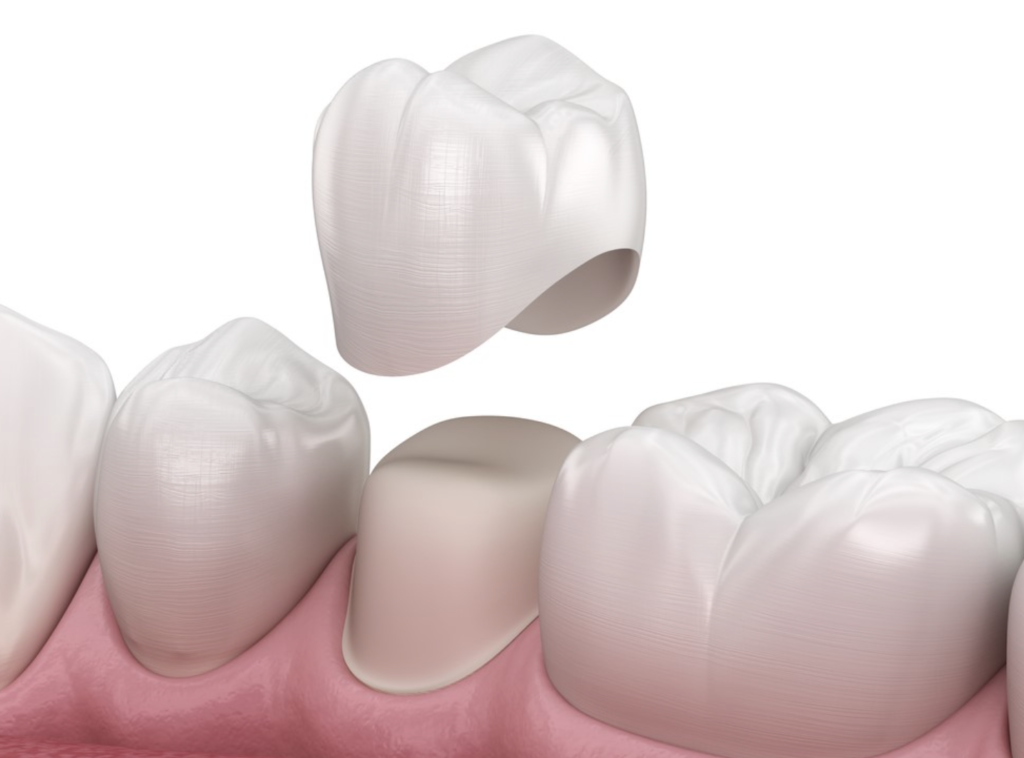Dental crowns are a cosmetic and restorative tool used in dentistry to cover cracked and chipped teeth, and are also useful for maintaining the structural integrity of a damaged tooth.
In simple words a dental crown is a small cap or helmet that covers a damaged tooth. It helps to restore the shape and look of the tooth and stops the chips and cracks from getting worse. Dental crowns can be also used to restore a tooth as part of a dental implant. The crown sets on top of the implant as the final stage of the process. Dental crowns can be made of porcelain, a composite material or metal alloys such as gold.


To begin the process is indispensable to polish some of the enamel from the tooth to make room for the crown. After that is going to be needed an impression of your teeth to design the crown and make sure that crown fits well, this can be done with mould making material or digital scanning technology. The crown can be made in a lab by an expert technician and can take a few days to be done. Therefore, maybe you have to make two trips to the dentist, one for the preparation and another to establish the restoration.
Another option to make dental crowns is with the help of a milling machine such as the CEREC machine. These use digital mouth scans and digitally tooth designs to precisely shape the restoration in a special machine. These crowns are then ready to be placed on the same day as your initial visit.
Once the crown has been manufactured it will be attached to the tooth.
Inlays and onlays are almost comparable to crowns but these do not fix the whole crown of the tooth. Inlays fix the dips in teeth and onlays fix the pointed parts of teeth.
The inlays and onlays require a process identical as a full crown but can take less time to make the restoration and usually have a lower cost.
The primary purpose of a crown is to cover or protect a damaged tooth.
So, if you’ve had a root canal or a very big cavity, we may suggest a dental crown to finish the treatment.
You may also need a crown as a part of a dental bridge or with dental implants.
Yes! We take impressions or imaging of your teeth and we will also match the color. Your smile can continue to look natural.
A filling is a great restoration for a smaller cavity. However, some cavities, especially those on your molars, can be so large that they essentially hollow out your tooth.
The root may be stable, but the tooth itself is a shell, and unable to withstand normal daily use. In this case, your tooth will be filled, but also needs to be covered by a crown for protection. If you have had root canal therapy to correct an abscessed tooth, it will also need to be covered by a crown.
The same way you care for your natural teeth! Brush twice a day, floss at least once, and rinse with an alcohol-free rinse in the evenings before bedtime!
You can eat most of the food you’ve been eating! Do try to avoid sticky and chewy foods like caramels or toffee, since those could possibly pull the crown off!
The lifespan of your restoration depends on the material you choose. All metal typically lasts longest, while ceramics and porcelains are more natural looking with a slightly shorter lifespan (although that’s not always the case anymore.) Most crowns are guaranteed for five years, but many people have them last as long as 20 years!
If you have a dental restoration fail, call us to have it replaced! This is emergency dental work that needs to happen ASAP!
If you have a question that wasn’t addressed above, our staff is happy to chat with you.
We’re also here to explain any of the above processes and procedures in greater detail.

From USA
From Mexico